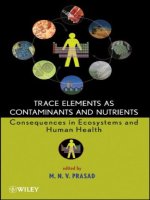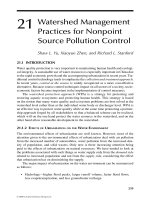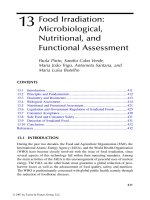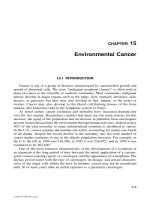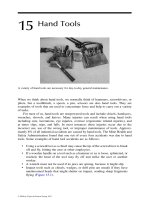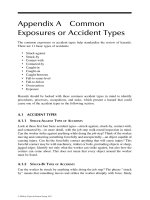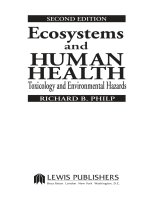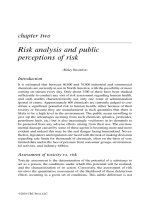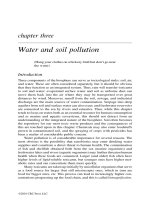Ecosystems and Human Health - Chapter 15 (end) docx
Bạn đang xem bản rút gọn của tài liệu. Xem và tải ngay bản đầy đủ của tài liệu tại đây (36.99 KB, 10 trang )
©2001 CRC Press LLC
chapter fifteen
Case study reviews
All case studies are based on actual occurrences.
Case study 1
This population of laboring miners has an incidence of a rare cancer many
times that of the general population, and those who live near the mine, as
well as family members of miners, have a lower, but still elevated, incidence
of the same cancer. The incidence of lung cancer in smoking miners is
60 times that in nonsmoking miners and several times higher than in smokers
who are not miners.
This is actually the situation in asbestos miners who were first employed
30 years ago or more. The cancer is mesothelioma. The miners carried home
the asbestos fibers on their clothing. Family members, especially the wives
who did the family laundry, inhaled these fibers. Living in close proximity
to the mine was also a risk factor, as particles were airborne over short
distances. Cigarette smoke and asbestos fibers were acting as co-carcinogens
and/or promoters to greatly increase the risk of lung cancer.
Socio-economic factors that might increase cancer incidence, in addition
to smoking, would include diet (high saturated fats and low fiber), high
alcohol consumption, lack of exercise, and other workplace hazards (e.g.,
benzene). Miners would likely be 18 to 65 years of age and predominantly
male, so that the elderly and the very young, as well as women, would be
excluded from the group at risk.
Case study 2
Working in a confined space always constitutes a risk whenever volatile
solvents or gases, explosive or otherwise, are in use. In this particular case,
explosion-proof electrical devices (lights, ventilating fans) should have been
available. Failing that, the ventilation fan could have been placed at a dis-
tance from the site and flexible, large-bore conduit used to conduct air into
the tank. The tank should have been pumped dry before attempting to work
in it. A safety person should have been left at the surface to summon help
©2001 CRC Press LLC
(not to enter the tank alone), and safety lines should have been attached to
the workers in the tank so that they could be recovered if they lost conscious-
ness. Breathing apparatus could have been used if available. Ideally, air
quality should have been tested before any workers were allowed into the
tank (O
2
> 19.5%; flammable substances < 10%; toxic chemicals to meet pub-
lished standards).
This accident took place in the Philippines, in a remote area. Epoxy paint
solvents may contain a variety of volatile substances that are sedating and
heavier than air. In this case, volatile glyceridyl ether was identified.
Case study 3
This 4-year-old boy had acrodynia, a rare form of childhood mercury poi-
soning. His 24-hr urine mercury level was 65
µ
g/L, as were those of his
mother and siblings. The house was air-conditioned and therefore sealed.
The interior latex paint used on the walls of the house was identified as
containing about 950 ppm mercury. Seventeen gallons had been applied to
the interior walls. The U.S. EPA allows the addition of 300 ppm mercury as
phenylmercuric acetate to interior latex paint as a fungicide and bactericide
to prolong shelf life. This limit was exceeded by more than threefold.
Case study 4
The manure pit is another example of the dangers of working in a confined
space. In this case, methane gas from the decomposition of the manure
displaced O
2
so that the workers died of asphyxiation. All of the safety
measures noted for Case study 2 apply here as well. It is almost unbelievable
that four men would consecutively enter the confined space, but it is a
testimony to how panic can overcome training and common sense. Over 25
people in the United States have died in this type of accident in the last
5 years.
Case study 5
Yet a further example of a “confined space” problem, these workers were
using a chlorofluorocarbon (Freon-113) as a degreasing agent in a pit beneath
a large piece of machinery when they were overcome and one died on route
to hospital. The portal of entry was obviously by inhalation, and the target
organs were the brain and the heart. CFCs are CNS depressants, causing
narcosis, stupor, and loss of consciousness. Asphyxiation may occur from
respiratory depression as well as from displacement of O
2
. These agents, like
the related anesthetics halothane and chloroform, sensitize the heart to
adrenaline, with resulting arrhythmias and ventricular fibrillation. A number
of years ago, sniffing CFCs in aerosol propellants became a cheap way of
getting “high” in some adolescent cultures. A number of deaths resulted
©2001 CRC Press LLC
from cardiac arrest. From 1983 to 1990, 12 deaths were recorded in the United
States from the industrial use of CFCs.
Case study 6
These Inuit soapstone carvers are exposed to the dust of their carving stones.
This can cause pneumoconiosis, similar to silicosis. Like the asbestos miners,
they could carry the dust home on their clothing and thus put their families
at risk as well. The use of respirators capable of filtering out the dust, and
of special workclothes left at the site, is a necessary safeguard.
Case study 7
The variety of signs and symptoms, not all of which are infectious, in these
agricultural workers do not suggest that the primary cause is a microorgan-
ism, but rather an inhaled pollutant. Potential airborne causative agents in
this environment would include animal dandruff, dried feces, grain dust,
dust from feed additives (antibiotics, sulfa drugs, minerals, etc.), parasites,
bacteria, bacterial endotoxins, fungi, ammonia (adsorbed onto dust parti-
cles), and methane. Many of these agents are allergens and an allergic com-
ponent may be present in some individuals.
Corrective measures could include improved ventilation, the use of filter
masks or respirators, damping down floors to control dust, and removal
from this work environment of anyone suffering from allergies or respiratory
disease. In many jurisdictions, agricultural workers are not protected by
workplace legislation.
Case study 8
The array of respiratory symptoms is strongly suggestive of an inhaled
toxicant. Because ice-surfacing machines use internal combustion engines,
CO poisoning should be suspected. Carboxyhemoglobin levels in blood
should be measured. This was done and values ranging from 10 to 20% were
found (normal levels are <2% for nonsmokers, 5 to 9% for smokers). CO
would account for the headache, nausea, and dizziness, but not for the
difficulty in breathing nor the coughing up of blood. This is a strong indi-
cation of nitrogen dioxide (NO
2
) poisoning.
The following day, tests were conducted with an ice resurfacing machine
equipped with an internal combustion engine. The machine had not been
serviced for some time. Levels of NO
2
reached 1.5 ppm. The standard set by
the U.S. Office of Safety and Health Administration (OSHA) is 1 ppm for
the Short Term Exposure Level (STEL), which has a 15-min limit. The CO
reached 150 ppm and may have been higher the previous evening. The
maximum recommended for ice arenas is 30 ppm.
©2001 CRC Press LLC
Case study 9
These family members became dizzy and nauseated after eating a snack food
purchased at a local convenience store. Two of them suffered convulsive
seizures. The brain is obviously the primary organ of toxicity. The rapid
onset (< 1 hr) indicates a preexisting toxin rather than an infectious agent.
Because common bacterial toxins do not produce this type of reaction, and
because the preparation did not involve seafood or mushrooms, the likely
offender is a chemical contaminant.
It is difficult to identify the source of the contaminant because all cases
involved the same retail outlet and the same manufacturer. The fact that the
snacks were prepackaged would suggest the manufacturer as the source,
but the nature of the package was not identified and it is not impossible that
some chemicals could penetrate paper or polyethylene bags.
Endrin is an organochlorine cyclodiene insecticide. No traces were found
in the store or the manufacturing plant. Another possibility is that the flour
from which the taquito snacks were made was contaminated. There have
been previous incidents of such contamination.
Signs of acute organochlorine intoxication include headache, nausea,
vomiting, dizziness, clonic jerking, and epileptiform seizures.
Case study 10
This is another case of a worker dying from exposure to fumes from a
volatile chlorinated hydrocarbon solvent being used as a degreaser. Trichlo-
roethane acts like CFCs to sensitize the heart and depress the CNS. Inade-
quate ventilation is the critical factor in all such cases (refer to Case Study
2). Chronic intoxication would have probably involved central necrosis of
the hepatic lobules.
Case study 11
These demolition workers were cutting up an old iron bridge. The organ
systems involved in the toxic reaction were the musculoskeletal system (joint
and muscle pain), the CNS (headache), and the gastrointestinal system (nau-
sea). This last symptom could also be central in origin, through stimulation
of the chemoreceptor trigger zone. The most likely portal of entry is the
lungs. These torch cutters would be wearing coveralls and gauntlets to
protect against sparks. The source of the toxicant is thus likely to be vapors
from the cutting process.
An old bridge of this nature is unquestionably going to be coated in
many layers of lead-based paint. Blood lead levels were performed and
ranged from 60 to 160
µ
g/dL. U.S. regulations require that workers having
levels >60
µ
g/dL be removed from the work site. The highest level was
©2001 CRC Press LLC
detected in the barge worker who did not benefit from the nearly constant
breeze encountered on the superstructure of the bridge. The paint from the
bridge was found to contain 30% lead by weight.
Treatment was initiated with chelation therapy (EDTA) and substantial
amounts of lead were excreted in the urine with an accompanying reduction
in symptoms.
The employer was fined for not providing appropriate respirators, clean
work clothing, and facilities for washing up before lunch and at the end of
the day.
Case study 12
This is another case of lead poisoning. The blood lead level was 70
µ
g/dL in
the primary patient and elevated in other family members. In chronic gastric
pain that cannot be attributed to an ulcer or cancer, a blood lead determina-
tion is useful, as gastric distress is a common symptom of lead poisoning.
The portal of entry in this case is almost certain to be oral because no
activities were in place that could have caused lead vapors. The ceramic jug
was suspect because it was imported from Mexico where lead glazing still
is used. The jug had been used to store a fermenting beverage, so that
considerable time was available for leaching to occur. The entire family
partook of this beverage over the course of the summer.
Case study 13
An investigation of the home environment revealed that the house had been
built after the banning of lead paints. Water was obtained from a well by
means of a galvanized pipe system, eliminating solder joints as a potential
source of the lead. No suspicious ceramic or pewter utensils were used for
food storage or preparation. All of this pointed to the work environment as
the source of contamination.
A 19-day course of treatment was begun with dimercaptosuccinic acid
(DMSA), an orally administered lead chelating agent. The patient was
instructed to remain off work during the treatment period. At the end of this
period, his blood lead level (BLL) fell to 13
µ
g/dL. One month after returning
to work it was back up to 53
µ
g/dL, confirming this environment as the
source of the lead.
Further careful questioning elicited the information that he habitually
chewed on bits of insulation cut from the ends of electrical wires. Analysis
of this colored plastic (white, blue, and yellow) indicated that it contained
10,000 to 39,000
µ
g of lead per gram of plastic. He was instructed to desist
from this habit and within 4 months his BLL fell to 24
µ
g/dL and he reported
a subjective improvement in his symptoms.
Lead, usually as lead chromate, is used in pigments employed in the
manufacture of colored plastics. Lead salts are used in the manufacture of
©2001 CRC Press LLC
polyvinylchloride (PVC) plastics. Thus, any colored plastic may contain lead
and should not be chewed or ingested. Cadmium is also present in a number
of pigments.
Lead sometimes appears as an unexpected contaminant in unusual cir-
cumstances. Ethnic health remedies are such examples. Lead, in amounts up
to 90% by weight, has been detected in “Azarcon” from Mexico (used as a
digestive aid), “Greta,” also from Mexico (same use), “Paylooah” from South-
east Asia (applied to inner lower eyelid to improve vision), and a substance
from Tibet given to improve development. All of these have resulted in raised
blood lead levels in children (20 to 80
µ
g/dL) and symptoms of lead poi-
soning (
Morbidity and Mortality Weekly Rep.
, 47, 522, 1993).
Case study 14
These five steam press operators became ill with a variety of signs and
symptoms suggesting involvement of the CNS, the blood, and the heart.
The use of a solvent-borne adhesive raises questions about ventilation of
the workplace; the nature of the solvent and its toxicity; whether respirators
were in use and, if so, were they approved for the task; and whether
protective gloves and clothing were in use. Because the steam presses had
been in use for many years without incident, it is important to carefully
probe to identify any changes in work habits or materials that might have
taken place recently.
A wide variety of aromatic nitro compounds are capable of causing
methemoglobinemia. Remember that nitrites are administered deliberately
in cases of cyanide poisoning to form methemoglobin, which has a higher
affinity for CN than does reduced hemoglobin. The top ten aromatic nitro
compounds implicated in methemoglobin formation include, in order of
decreasing potency,
ortho
-chloraniline, dinitrobenzene,
meta
-nitroaniline,
para
-toluidine, nitrobenzene,
meta
-toluidine,
ortho
-nitrochlorobenzene,
aniline,
para
-dinitrosobenzene, and
ortho
-toluidine.
Because analysis of air samples was not helpful, analysis of the actual
solvent should be undertaken if possible. Analysis of the adhesive in use at
the time of the toxic event was undertaken and the results compared with
a newly delivered lot. Samples were extracted with carbon disulfide/meth-
anol and analyzed by gas chromatography with flame ionization detection.
The “old” sample was found to contain 1% by weight
para
-dinitrobenzene
(pDNB) vs. 0.03% in the new sample. Tracing the product back to the
manufacturer, it was found that a proprietary solvent used in the prepara-
tion of the adhesive was contaminated with pDNB. MetHb levels were
monitored after the removal of the contaminated lot and found to be normal.
Periodic monitoring was instituted, and workers were required to wear
butyl rubber gloves because it was felt that significant skin absorption may
have been occurring.
©2001 CRC Press LLC
Case studies 15 and 16
The rapid onset of symptoms in both cases — the hemodialysis patient and
the people who attended the picnic — makes it unlikely that an infectious
agent is involved. There are no water-borne bacterial toxins that could
account for the symptoms. The CNS appears to be the organ system to which
most symptoms are related (sleepiness, dizziness, etc.).
In both cases, it emerged that the potable water system was cross-
connected with a chilled water system used for air conditioning. Ethylene
glycol was used as an antifreeze. The ethylene glycol diffused into the tap
water and was consumed by those at the picnic and diffused across the
dialysis membrane into the bloodstream of the patient with renal disease.
Ethylene glycol acts first as an intoxicant similar to alcohol. Subsequently,
the formation of oxalate occurs. This chelates calcium to form calcium
oxalate, which precipitates in the kidneys and other tissues to cause renal
failure and other tissue damage. Blood calcium levels are low also because
of the binding of calcium to oxalate. Ethanol is administered because alcohol
dehydrogenase is the metabolic enzyme for ethylene glycol but ethanol is
the preferred substrate.
Case study 17
These patrons of a Chinese restaurant most likely took in something orally.
Again, the rapid onset of symptoms suggests a preexisting substance rather
than an infectious agent. The signs and symptoms relate to the CNS. The
symptoms are not compatible with known pesticide toxicity.
The physician inquired about fish and mushroom consumption because
a type of scalefish poisoning produces similar symptoms. Toxic mushrooms
(toadstools) also might have been responsible.
The fact that only these three patrons consumed a particular dish is
helpful. Inquiry revealed that this particular dish, pork chow yuk, had been
prepared by three different chefs. Each had added monosodium glutamate
to the full amount, resulting in concentrations three times normal. This is a
classical case of “Chinese restaurant syndrome.”
Case study 18
This crop-duster pilot is displaying characteristic signs of excessive cholin-
ergic activity. The signs and symptoms are opposite to those of atropine
overdose and include pupillary constriction, visual disturbances, mental
confusion and other mental disturbances, profuse sweating, dizziness, weak-
ness, and diarrhea. Parathion is an organophosphorus insecticide. Question-
ing revealed that the pilot had been careless in handling the concentrated
stock solution, had not worn protective clothing, including gloves, and had
not worn a respirator. The signs and symptoms of organophosphorus
©2001 CRC Press LLC
poisoning result from its irreversible inhibition of cholinesterase and are
frequently delayed. Treatment would consist of atropine to block the effects
of acetylcholine overload and pralidoxime to reactivate the acetylcholinest-
erase enzyme by removing the phosphate group.
Pralidoxime would be contraindicated if a non-organophosphorus inhib-
itor of acetylcholinesterase had been used, such as a carbamate like Sevin.
Because no phosphate is involved, no antidotal response occurs, and the
situation could be worsened because pralidoxime has some anticholinest-
erase activity in its own right.
Plasma cholinesterase levels and red-cell acetylcholinesterase would be
depressed in this individual.
Case study 19
The signs and symptoms of this outbreak are characteristic of poisoning with
a cholinesterase inhibitor. Questioning revealed that 23 of the men had been
involved in the mixing, loading, or application of mevinphos, an organo-
phosphorus insecticide being used for aphid control. It has high toxicity
(EPA Class 1). The remaining men had entered and worked in orchards
within 24 hr of spraying.
Questioning of the orchard operators revealed that protective clothing
or equipment either was not available or had not been used. Respirators,
gloves, goggles, coveralls, and rubber footwear are recommended and, in
some jurisdictions, required by law.
Seven individuals required hospitalization. Their plasma and red blood
cell cholinesterase levels were depressed 75 to 95%. Other workers were
treated as outpatients and had levels depressed by 15 to 25%. Atropine was
given to a total of 11 patients.
Case study 20
This restaurant-related syndrome involved a small number of patrons (6)
out of 48 who had eaten lunch there. Careful inquiry should be undertaken
to determine whether these six people had eaten anything different from the
others. It emerged, after questioning these and other available patrons, that
the six had consumed yellow-fin tuna. On the surface, this resembles a
monosodium glutamate (MSG) reaction, but the chefs adamantly denied
using this flavor enhancer in the fish dish. The persistence of the symptoms,
up to 9 hr, also argues against MSG as the cause of the reaction.
Three of the affected individuals reported that the tuna had a distinctly
peppery or “Cajun” taste; but again, the chefs claimed not to have used any
such spicing.
This is a typical case of scombroid fish poisoning. Analysis of the yellow-
fin tuna revealed histamine levels of 50 to 160 mg/100 g (normal <1 mg/100 g).
A telephone survey of hospital emergency departments in the city uncovered
nine more cases over a period of two days. All had eaten yellow-fin tuna,
©2001 CRC Press LLC
either in restaurants or in the home. Investigation did not elicit any evidence
of a serious lapse in refrigeration or handling. The fish were cleaned and
packed in ice onboard the fishing boat, and delivered by refrigerated vehicle
to a distributor where they were repacked in ice in smaller lots for delivery
to retailers and restaurants. It was extremely hot during the period of the
outbreak, however.
All cases were treated successfully with oral antihistamines. In asthmat-
ics and cardiac patients, the condition can be life-threatening, requiring more
intensive emergency treatment.
Case study 21
One would want to inquire carefully as to recent ingestion of food, especially
seafood, given the environment. These six sport fishermen consumed blue
mussels that had been collected in deep water far offshore by commercial
fishing boats. This makes bacterial contamination from sewage effluent or
other human sources unlikely. The toxin is obviously a neurotoxin. Shellfish
toxins that must be considered include domoic acid (amnesic shellfish poi-
soning), okadaic acid (diarrhetic shellfish poisoning), and saxitoxin (paralytic
shellfish poisoning). Tingling and loss of sensation are strongly indicative of
saxitoxin poisoning. Significantly, the episode occurred in June, when red
tides would be more common in the Northern Hemisphere.
The symptomatology and mechanism of action of saxitoxin are identical
to those of tetrodotoxin from fugu (puffer fish).
Analysis of the remaining blue mussels revealed saxitoxin levels of
25,000
µ
g/100 g in uncooked mussels and 4300
µ
g/100 g in cooked mussels.
The boiling destroyed much of the saxitoxin; otherwise, the attacks would
have been fatal, as they were in a similar incident in which clams were
steamed but not boiled. The raw clams contained up to 13,000
µ
g/100 g of
saxitoxin, most of which survived the steaming.
Case study 22
In this case, the differential diagnosis must include food poisoning (some of
the symptomatology could be due to
Salmonella
infection or
Staphylococcus
toxin), a chemical contaminant such as a pesticide, or some other cause. The
time to onset is not suggestive of poisoning by a preexisting toxin as in staph
food poisoning. Careful questioning might reveal whether a possible source
of
Salmonella
existed in the diet (e.g., undercooked eggs, chicken, or beef).
The symptomotology is reminiscent of poisoning by an organophosphorus
insecticide (see Case Study 16) but it is unlikely that spraying to control
insects would occur so close to harvesting the tobacco.
This is a condition known as green tobacco disease. It is due to the
absorption across the skin of nicotine and it characteristically occurs in
periods of wet weather. The signs and symptoms are those of stimulation
of nicotinic receptors in the ganglia of the autonomic nervous system and
©2001 CRC Press LLC
of the neuromuscular junction. Some of the symptoms will relate to para-
sympathetic stimulation, as do those of organophosphorus poisoning.
Case study 23
This poisoning obviously involves the gastrointestinal tract and the periph-
eral nervous system with different times-to-onset of signs and symptoms.
Without knowing the common denominator (amberjack), one would initially
have to consider an infectious agent, a contamination occurring in the res-
taurant, and a preexisting toxin. Stool and vomitus cultures were negative
for all common bacterial causes of gastroenteritis (
Salmonella, Shigella, Campy-
lobacter
, and
Yersinia
). Monosodium glutamate (MSG) has a different array
of symptoms and a more rapid time-to-onset. Seafoods that could be respon-
sible include shellfish (diarrhetic shellfish poisoning, paralytic shellfish poi-
soning) and scalefish (scombroid and ciguatera poisoning). Shellfish poison-
ing is ruled out by the commonality of amberjack consumption. The rapid
onset of histamine-related symptoms of scombroid poisoning are lacking.
The combination of gastrointestinal and neurological symptoms is charac-
teristic of ciguatera poisoning. Analysis of samples of the amberjack by
mouse bioassay was positive for ciguatera-type biotoxins.
Case study 24
The rapidity of symptom onset after ingesting the root points clearly to this
as the source of the toxin. There is also a clear dose dependency because the
man who consumed three bites died, whereas his brother, who ate only one
bite, survived. This is a classical case of water hemlock poisoning, with
cicutoxin as the causative agent. The involvement of the gastrointestinal tract
and the central nervous system is typical.
Case study 25
These teenagers had collected some jimsonweed from an empty lot taken
over by weeds. They had consumed some of the seeds from the seed pod.
These are rich in scopolamine and atropine, muscarinic blocking agents with
central effects. This accounts for the hallucinations (typically involving
insects), confusion, combative behavior, disorientation, seizures, and coma.
Peripheral effects include dry mouth, blurred vision and photophobia, and
urinary retention.
Treatment is supportive and may include induced emesis and activated
charcoal to decontaminate the gastrointestinal tract, plus physostygmine
(a cholinesterase inhibitor) to increase the availability of acetylcholine.
